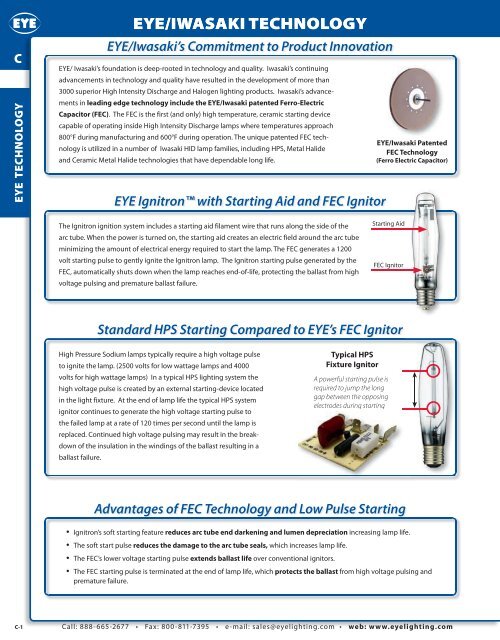IWASAKI LIGHTING - EYE Lighting International of North America, Inc.
IWASAKI LIGHTING - EYE Lighting International of North America, Inc.
IWASAKI LIGHTING - EYE Lighting International of North America, Inc.
You also want an ePaper? Increase the reach of your titles
YUMPU automatically turns print PDFs into web optimized ePapers that Google loves.
C<br />
<strong>EYE</strong> TECHNOLOGY<br />
<strong>EYE</strong>/<strong>IWASAKI</strong> TECHNOLOGY<br />
<strong>EYE</strong>/Iwasaki’s Commitment to Product Innovation<br />
<strong>EYE</strong>/ Iwasaki’s foundation is deep-rooted in technology and quality. Iwasaki’s continuing<br />
advancements in technology and quality have resulted in the development <strong>of</strong> more than<br />
3000 superior High Intensity Discharge and Halogen lighting products. Iwasaki’s advancements<br />
in leading edge technology include the <strong>EYE</strong>/Iwasaki patented Ferro-Electric<br />
Capacitor (FEC). The FEC is the first (and only) high temperature, ceramic starting device<br />
capable <strong>of</strong> operating inside High Intensity Discharge lamps where temperatures approach<br />
800°F during manufacturing and 600°F during operation. The unique patented FEC technology<br />
is utilized in a number <strong>of</strong> Iwasaki HID lamp families, including HPS, Metal Halide<br />
and Ceramic Metal Halide technologies that have dependable long life.<br />
<strong>EYE</strong> Ignitron with Starting Aid and FEC Ignitor<br />
The Ignitron ignition system includes a starting aid filament wire that runs along the side <strong>of</strong> the<br />
arc tube. When the power is turned on, the starting aid creates an electric field around the arc tube<br />
minimizing the amount <strong>of</strong> electrical energy required to start the lamp. The FEC generates a 1200<br />
volt starting pulse to gently ignite the Ignitron lamp. The Ignitron starting pulse generated by the<br />
FEC, automatically shuts down when the lamp reaches end-<strong>of</strong>-life, protecting the ballast from high<br />
voltage pulsing and premature ballast failure.<br />
Standard HPS Starting Compared to <strong>EYE</strong>’s FEC Ignitor<br />
High Pressure Sodium lamps typically require a high voltage pulse<br />
to ignite the lamp. (2500 volts for low wattage lamps and 4000<br />
volts for high wattage lamps) In a typical HPS lighting system the<br />
high voltage pulse is created by an external starting-device located<br />
in the light fixture. At the end <strong>of</strong> lamp life the typical HPS system<br />
ignitor continues to generate the high voltage starting pulse to<br />
the failed lamp at a rate <strong>of</strong> 120 times per second until the lamp is<br />
replaced. Continued high voltage pulsing may result in the breakdown<br />
<strong>of</strong> the insulation in the windings <strong>of</strong> the ballast resulting in a<br />
ballast failure.<br />
Typical HPS<br />
Fixture Ignitor<br />
Advantages <strong>of</strong> FEC Technology and Low Pulse Starting<br />
<strong>EYE</strong>/Iwasaki Patented<br />
FEC Technology<br />
(Ferro Electric Capacitor)<br />
Starting Aid<br />
FEC Ignitor<br />
A powerful starting pulse is<br />
required to jump the long<br />
gap between the opposing<br />
electrodes during starting.<br />
• Ignitron’s s<strong>of</strong>t starting feature reduces arc tube end darkening and lumen depreciation increasing lamp life.<br />
• The s<strong>of</strong>t start pulse reduces the damage to the arc tube seals, which increases lamp life.<br />
• The FEC’s lower voltage starting pulse extends ballast life over conventional ignitors.<br />
• The FEC starting pulse is terminated at the end <strong>of</strong> lamp life, which protects the ballast from high voltage pulsing and<br />
premature failure.<br />
C-1 Call: 888-665-2677 • Fax: 800-811-7395 • e-mail: sales@eyelighting.com • web: www.eyelighting.com


